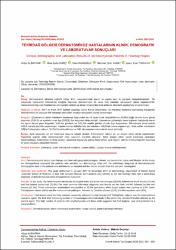| dc.contributor.author | Albayrak, Hülya | |
| dc.contributor.author | Raimoğlu, Onur | |
| dc.contributor.author | Aydın Kurç, Mine | |
| dc.contributor.author | Yanık, Mehmet Emin | |
| dc.contributor.author | Topkaya, Aynur Eren | |
| dc.date.accessioned | 2022-05-11T14:14:07Z | |
| dc.date.available | 2022-05-11T14:14:07Z | |
| dc.date.issued | 2020 | |
| dc.identifier.issn | 2587-0262 | |
| dc.identifier.issn | 2587-0262 | |
| dc.identifier.uri | https://doi.org/10.37696/nkmj.659002 | |
| dc.identifier.uri | https://app.trdizin.gov.tr/makale/TkRZd01URTBOQT09 | |
| dc.identifier.uri | https://hdl.handle.net/20.500.11776/5790 | |
| dc.description.abstract | Amaç: Dermatomikoz etkenleri coğrafik bölge, iklim, sosyoekonomik durum ve yaşam tarzı ile zamanla değişebilmektedir. Buçalışmada hastanemiz Dermatoloji kliniğine başvuran dermatomikoz ön tanısı olan hastaları retrospektif olarak değerlendirdik.Hastanemize başvuran hastalardaki demografik verilerin ve alınan örneklerden izole edilecek etkenlerin saptanması amaçlanmıştır.Materyal ve Metot: 2017 ile Aralık 2017 tarihleri arasında Namık Kemal Üniversitesi Tıp Fakültesi Hastanesi Dermatoloji Kliniğindendermatomikoz ön tanısıyla 448 hastadan elde edilen örnekler retrospektif olarak incelenmiştir.Bulgular: Çalışmamıza alınan hastaların hastaneye başvuruları en sık ayak tırnak değişikliklerine (%28,5) bağlı olurken bunu gövdelezyonları (%24,3) ve ayaktaki tırnak dışı (%22,5) deri lezyonları takip etmiştir. Laboratuvar yöntemiyle tanısı dışlanan hastalarda ise ensık ayırıcı tanıya giren lezyonlar; %44,4ile gövdede ve %22,2ile ayakta görülen (tırnak dışı) lezyonlardır. Mikroskopik direkt bakıda%35,8 vakada pozitiflik saptanmıştır. Yapılan mantar kültürlerinde tüm vakaların %5,8’inde üreme saptanmıştır. İzole edilen mantarların%56’sıTrichophyton rubrum, %12’si Candida albicans ve %8’i Microsporum canis olarak tespit edilmiştir.Sonuç: Ayak lezyonları en sık hastaneye başvuru sebebi olurken, Trichophyton rubrum en sık üreyen etken olarak saptanmıştır.Toplumda giderek artan immünsüpresif birey sayısının Candida albicans’ı ikinci üreyen etken olarak karşımıza çıkardığınıdüşünmekteyiz. Onikomikoz ve tinea pedisin hastaneye başvuruda sayıca fazla olması ayak hijyeni, bakımı ve korunmasının toplumsalbir sorun olduğunu düşündürmektedir. | en_US |
| dc.description.abstract | Aim: Dermatomycosis factors can change over time with geographical region, climate, socioeconomic status and lifestyle. In this study, we retrospectively evaluated the patients who admitted our dermatology clinic with the preliminary diagnosis of dermatomycosis. Demographic data of the patients who admitted to our hospital and the factors isolated from the samples investigated. Materials and Methods: This study performed in January 2017 to December 2017 at Dermatology Department of Namık Kemal University School of Medicine. A total 448 samples obtained from patients who referred to the Dermatology clinic with a preliminary diagnosis of dermatomycosis were retrospectively evaluated. Results: In our study, the most frequent admissions to hospital were due to toe nail changes (28.5%), followed by trunk lesions (24.3%) and foot lesions except nail (22.5%).The most common differential diagnosis was lesions on the trunk (44.4%) followed by foot skin lesions (22.2%). Direct microscopic examination was positive in 35,8% specimens while fungal culture was positive in 5,8% cases. Trichophyton rubrum (56%) was the most common pathogen, followed by Candida albicans (12%) and Microsporum canis (8%). Conclusion: Foot lesions were the most common reason for admission to the hospital and Trichophyton rubrum was the most common causative agent. We think that increasing number of immunosuppressive individuals in the community revealed Candida albicans as the second agent. The high number of patients with onychomycosis and tinea pedis suggests that foot hygiene, care and protection is a social problem. | en_US |
| dc.language.iso | tur | en_US |
| dc.identifier.doi | 10.37696/nkmj.659002 | |
| dc.rights | info:eu-repo/semantics/openAccess | en_US |
| dc.title | Tekirdağ Bölgesi Dermatomikoz Hastalarının Klinik, Demografik ve Laboratuvar Sonuçları | en_US |
| dc.title.alternative | Clinical, Demographic and Laboratory Results of Dermatomycosis Patients in Tekirdag Region | en_US |
| dc.type | article | en_US |
| dc.relation.ispartof | Namık Kemal Tıp Dergisi | en_US |
| dc.department | Fakülteler, Tıp Fakültesi, Dahili Tıp Bilimleri Bölümü, Deri ve Zührevi Hastalıkları Ana Bilim Dalı | en_US |
| dc.department | Fakülteler, Tıp Fakültesi, Temel Tıp Bilimleri Bölümü, Tıbbi Mikrobiyoloji Ana Bilim Dalı | en_US |
| dc.identifier.volume | 8 | en_US |
| dc.identifier.issue | 2 | en_US |
| dc.identifier.startpage | 234 | en_US |
| dc.identifier.endpage | 239 | en_US |
| dc.institutionauthor | Albayrak, Hülya | |
| dc.institutionauthor | Raimoğlu, Onur | |
| dc.institutionauthor | Aydın Kurç, Mine | |
| dc.identifier.trdizinid | TkRZd01URTBOQT09 | en_US |



















